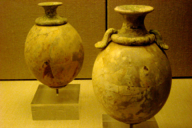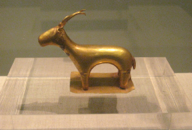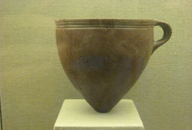Museum of Prehistoric Thira
FIRA, SANTORINI, CYCLADES ISLANDS
THE AEGEAN SEA, GREECE
THE HELLENIC REPUBLIC
SOUTHEASTERN Europe
OCTOBER 5, 2008


Museum of Prehistoric Thira
FIRA, SANTORINI, CYCLADES ISLANDS
THE AEGEAN SEA, GREECE
THE HELLENIC REPUBLIC
SOUTHEASTERN Europe
OCTOBER 5, 2008




The Museum of Prehistoric Thira (Santorini) in the town of Fira presented the story of life on the island dating to the mid-6th millennium, B.C.. The collection consists mainly of objects found at Akrotiri, the fishing village which developed c. 3,000 B.C. during the Early Cycladic Culture. The permanent exhibition charts the development of this culture from Neolithic fishing village, to large urban center, and one of the greatest ports in the Aegean before the Mature Late Cycladic Period of the 17th century B.C. Most of the objects displayed in the museum were found at the archaeological site of Akrotiri, which is now closed because of the collapse of a roof structure built to protect it. However, this museum has installed a collection of artifacts in a formal, logical, and scholarly manner, to captivate the visitor and reveal the beauty and intelligence of the early inhabitants. Many examples of an advanced culture are revealed in the decorative ceramics, religious and ritual objects, stone and ceramic vases, bronze tools, and complex wall paintings. The archaeological site of Akrotiri has presented evidence that early seismic warnings allowed the inhabitants to leave the island before the devastating earthquakes which occurred in the 17th century B .C.. The study of the history of ceramics alone reveals finds of local and imported pottery, when Akrotiri was at its zenith as a commercial port. It also provides evidence of the inhabitants’ abandonment of this island. I found the elegance, beauty and craftsmanship of the displayed objects, as well as the frescoes, to be stunning evidence of an intelligent civilization.
PHOTOS: Left Column: 1. Bull Rhyta, a ritual vessel, possibly of religious significance. Akrotiri. Mature Late Cycladic I period (17th c. B.C.). 2. Portable clay oven. Akrotiri. Mature Late Cycladic I period (17th c. B.C.). 3. Large cylindrical pithoi with dolphins and lilies. Mature Late Cycladic I period (17th c. B.C.) 4. Center, Top: Wall painting from the House of the Ladies. Akrotiri. Mature Late Cycladic I period (17th c. B.C.). Center, Bottom: Wall painting of the Blue Monkeys, Room Beta 6, Akrotiri. Mature Late Cycladic I period (17th c. B.C.). This painting and its decorative crowning zone of related colors is a masterpiece. It is thought that the painter had a direct image of the monkeys, which were later imported to the Aegean from the Mediterranean. Right Column: 1. Bronze baking pan. Akrotiri. Mature Late Cycladic I period (17th c. B.C.). 2. Plaster cast of a carved wooden table. Akrotiri. Mature Late Cycladic I period (17th c. B.C.). 3. A gold figurine found at Akrotiri on December 12, 1999. Unique of its kind, it was discovered in mint condition, inside a wooden box. The box was found inside a clay chest, next to a large pile of pairs of horns, mainly those of goats. The figure is hollow, was cast by the lost-wax method. The legs, neck and tail of the animal were soldered on after the removal of the inside core. The finishing process, hammering, left marks of the tool. 4. Minoan stone vase, Akrotiri, mature Late Cycladic I period (17th c. B.C.) .


Frescoes and Artifacts






